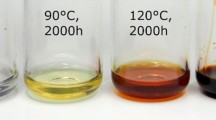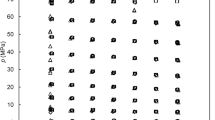Abstract
In order to increase the life of spacecraft, it is important to improve the comprehensive lubrication performance. Multiple alkylated cyclopentane (MAC) lubricants are presently gaining wide acceptance for actual space applications; adding extreme pressure additive is a strategy to improve lubrication performance. In this study, taking 1,3,4-tri-(2-octyldodecyl) cyclopentane as base oil, tricresol phosphate (traditional additive) and tri-(2-octyldodecyl) phosphate (developmental additive) have been screened computationally for compatibility, shear film forming and energy dissipation. Theoretical results indicate that (a) tricresol phosphate additive is not suited for addition to 1,3,4-tri-(2-octyldodecyl) cyclopentane lubricant due to limited compatibility; (b) tri-(2-octyldodecyl) phosphate is an excellent lubricant additive due to its perfect compatibility, ease of forming a shear film on the surface of friction pairs, higher strength, and low energy dissipation; and (c) lubrication occurs through the solid-liquid composite lubrication mechanism. These theoretical results were confirmed experimentally.
Article PDF
Similar content being viewed by others
Avoid common mistakes on your manuscript.
References
Gschwender L J, Snyder C E J, Massey M, Peterangelo S C. Improved liquid/grease lubricants for space mechanisms. Lubr Eng 56(12): 25–31 (2000)
Nian J Y, Gao P, Wang Y C, Guo Z G, Liu W M. Theoretical investigation of atomic oxygen erosion mechanisms of 1,3-didecyl cyclopentane, 1,3-dioctyldodecyl cyclopentane and alkylated cyclopentane. RSC Adv 4: 50486–50493 (2014)
Venier C G, Casserly E W. Multiply-alkylated cyclopentanes (MACs): A new class of synthesized hydrocarbon fluids. Lubr Eng 47: 586–591 (1991)
Dube M J, Bollea D, Jones W R, Marrcheti M, Jansen M J. A new class of synthetic hydrocarbon fluid lubricantfor space applications. Tribol Lett 15: 3–8 (2003)
Ma J Q, Pang C J, Mo Y F, Bai M W. Preparation and tribological properties of multiply-alkylated cyclopentane (MAC)–octadecyltrichlorosilane (OTS) double-layer film on silicon. Wear 263: 1000–1007 (2007)
Sun C F, Zhang M, Zhou F, Gao P, Xia Y Q, Liu W M. tribological behavior of multiply-alkylated cyclopentanes (MACs)-Cu nanoparticles composite thin film. J Macromol Sci Part B: Phys 50: 1006–1017 (2011)
Braza J, Jansen M J, Jones W. R. Lubricated bearing lifetimes of a multiply alkylated cyclopentane and a linear perfluoropolyether fluid in oscillatory motion at elevated temperatures in ultrahigh vacuum. NASA CR 21: 5637 (2009)
Song Z H, Cai M R, Liang Y M, Fan M J, Zhou F, Liu W M. In situ preparation of anti-corrosion ionic liquids as the lubricant additives in multiply-alkylated cyclopentanes. RSC Adv 3: 21715–21721 (2013)
Mo Y, Chau A, Wan Y, Lu Z, Huang F. Fabrication and tribological properties of a multiply-alkylated cyclopentane/reduced graphene oxide composite ultrathin film. Carbon 65: 261–268 (2013)
Fan X Q, Wang L P. Graphene with outstanding antiirradiation capacity as multialkylated cyclopentanes additive toward space application. Sci Rep 5: 12734 (2015)
Biebera H E, Klausb E E, Tewksbury E J. A study of tricresyl phosphate as an additive for boundary lubrication. A S L E Trans 11: 155–161 (1968)
Peterangelo S C, Gschwender L C E S, Nguyen W R J Q G, Jansen M J. Improved additives for multiply alkylated cyclopentane-based lubricants. J Synth Lubr 25: 31–41(2008)
Didziulis S V, Fleischauer P D. Chemistry of the extremepressure lubricant additive lead naphthenate on steel surfaces. Langmuir 12(7): 2981–2990 (1991)
Bird R J, Galvin G D. The application of photoelectron spectroscopy to the study of EP films on lubricated surfaces. Wear 34: 143–167 (1976)
Fan C F, Olafson B D, Blanco M. Hsu S L. Application of molecular simulation to derive phase diagrams of binary mixtures. Macromolecules 25: 3667 (1992)
Pesci A I, Freed K F. Lattice models of polymer fluids: Monomers occupying several lattice sites. II. Interaction energies. J Chem Phys 90: 2003 (1989)
Flory P J. Principles of Polymer Chemistry. Ithaca: Cornell University Press, 1953.
Mayo S L, Olafson B D, Goddard W A. DREIDING: A generic force field for molecular simulations. J Phys Chem 94: 8897–8909(1990)
Green M S. Markoff random processes and the statistical mechanics of time-dependent phenomena. II. Irreversible processes in fluids. J Chem Phys 22(3): 398 (1954)
Wang J H. Synthesis of Triphosphate and Triphosphorous Acid Ester. Leather Chem 5: 26–29 (1998)
Gao P, Liu W M, Liang Y M, Sun C F. Method for preparing Guerbet alcohol. CN Patent 102020533A, Apr. 2011.
Venier C G, Casserly E W. Lubricants comprising novel cyclopentanes, cyclopentadienes, cyclopentenes, and mixtures thereof and methods of manufacture. US Patent 5012023, 1991.
Author information
Authors and Affiliations
Corresponding authors
Additional information
Jingyan NIAN. He received his master degree in physical chemistry in 2012 from Northwest Normal University, Lanzhou, China. During his undergraduate, he joined the State Key Laboratory of Solid Lubrication at Lanzhou Institute of Chemical Physics, Chinese Academy of Sciences. His current position is an associate researcher. His research area covers the atomic-scale friction, superlubricity, and space lubrication.
Yifan SI. He joined Prof. Guo’s biomimetic materials of tribology (BMT) group at University of Hubei in 2014 in pursuing his Ph.D. degree. His current scientific interests are devoted to designing and fabricating superhydrophobic nanocoatings and studying their corresponding applications.
Zhiguang GUO. He received his Ph.D. degree from Lanzhou Institute of Chemical Physics (LICP), Chinese Academy of Sciences (CAS) in 2007. During Feb. 2009 to Feb. 2010, he worked in Department of Physics, University of Oxford, UK, as a visiting scholar. Now he is a full professor in LICP financed by “Top Hundred Talents” program of CAS. Till now, he has published more than 130 papers about the interfaces of materials.
Ping GAO. She got her B.S. degree in 1989 in Lanzhou University, China. She is currently an associate professor in State Key Lab of Solid Lubrication, LICP, CAS. Her research interests mainly include organic synthesis and chemistry of materials.
Weimin LIU. He received his Ph.D. degree with major of lubricating materials and tribology from Lanzhou Institute of Chemical Physics (LICP), Chinese Academy of Sciences in 1990. In 2013, he was elected as the fellow of Chinese Academy of Sciences, and now, he is the director of the state key lab of solid lubrication. Up to now, he has published more than 500 papers and his research interests mainly focus on space lubrication and high performance lubricants.
Rights and permissions
Open Access This article is licensed under a Creative Commons Attribution 4.0 International License, which permits use, sharing, adaptation, distribution and reproduction in any medium or format, as long as you give appropriate credit to the original author(s) and the source, provide a link to the Creative Commons licence, and indicate if changes were made.
The images or other third party material in this article are included in the article’s Creative Commons licence, unless indicated otherwise in a credit line to the material. If material is not included in the article’s Creative Commons licence and your intended use is not permitted by statutory regulation or exceeds the permitted use, you will need to obtain permission directly from the copyright holder.
To view a copy of this licence, visit https://creativecommons.org/licenses/by/4.0/.
About this article
Cite this article
Nian, J., Si, Y., Guo, Z. et al. Characterizing a lubricant additive for 1,3,4-tri-(2-octyldodecyl) cyclopentane: Computational study and experimental verification. Friction 4, 257–265 (2016). https://doi.org/10.1007/s40544-016-0124-8
Received:
Revised:
Accepted:
Published:
Issue Date:
DOI: https://doi.org/10.1007/s40544-016-0124-8




